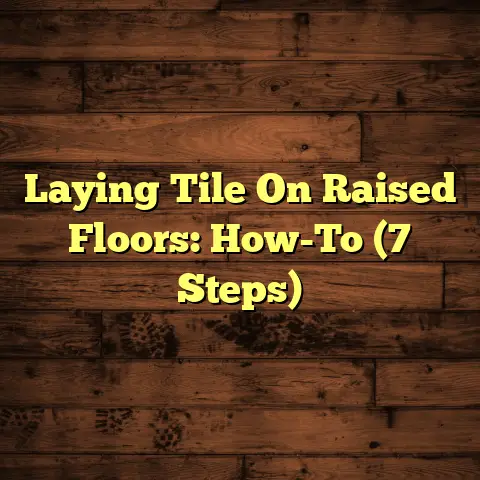How To Clean Floor Tiles Streak Free? (Explained)
Cleaning floor tiles to achieve that impeccable, streak-free finish isn’t just a chore; it’s an art form.
Over the years, I’ve spent countless hours perfecting my technique, learning from both my successes and setbacks.
The journey has taught me that the right approach can transform a mundane task into a simple, satisfying process.
The Timelessness of Clean Floors
Timeless beauty is often found underfoot.
Whether you’re stepping into a cozy home or a bustling business, the first thing that greets you is the floor.
For many, tiled floors evoke a sense of elegance and cleanliness.
I remember the first time I walked into a home with stunning tilework; I was captivated by how it seemed to elevate the entire space.
However, maintaining that pristine look can be challenging.
In my early days as a flooring contractor, I often underestimated the importance of proper cleaning techniques.
I thought a simple mop and bucket would suffice.
But after encountering streaks and dullness, I realized there was much more to it.
Have you ever felt that frustration?
It’s a common scenario, especially for those who take pride in their living spaces.
Gathering the Right Supplies
To embark on this cleaning journey, having the right supplies is essential.
Over time, I’ve streamlined my toolkit to include only what truly makes a difference.
Here’s what I always have on hand:
- Microfiber Mop: This is my go-to tool.
The fibers are gentle yet effective at capturing dirt without scratching the surface. - Bucket: A sturdy bucket is crucial for mixing cleaners and holding water.
- Tile Cleaner: I prefer pH-neutral cleaners because they’re safe for various tile types without causing damage.
- Warm Water: Not only does warm water help dissolve dirt better, but it also enhances the effectiveness of your cleaning solution.
- Baking Soda: For stubborn stains, a paste of baking soda can work wonders.
- White Vinegar: A natural cleaning agent that helps break down grime when used correctly.
- Soft Brush or Toothbrush: For scrubbing hard-to-reach areas or stubborn stains.
Understanding Your Tiles
The type of tile you’re working with significantly influences how you should clean it.
Each type has its nuances that can make or break your cleaning efforts:
- Ceramic Tiles: Generally easy to clean with pH-neutral cleaners, they resist stains well.
- Porcelain Tiles: More durable and less porous than ceramic, they require similar care but can handle more abrasive cleaning solutions if necessary.
- Natural Stone Tiles: This is where caution is needed.
Marble, granite, and slate require special cleaners designed for stone, as acidic substances can etch or damage them. - Vinyl Tiles: While not as common in high-end settings, they still require gentle cleaning to maintain their appearance.
My Cleaning Process: A Step-by-Step Guide
1. Preparation is Key
Before diving into cleaning, preparation is essential.
Sweeping or vacuuming to remove loose dirt and debris ensures that you won’t be grinding dirt into the tiles while mopping.
When I first started out, I sometimes skipped this step in my eagerness to see results.
The outcome?
More streaks and a less-than-satisfactory finish.
2. Mixing Your Cleaning Solution
In a clean bucket, mix warm water with your chosen tile cleaner according to the manufacturer’s instructions.
Typically, I use about a quarter cup of cleaner per gallon of water.
For particularly grimy areas, I sometimes double the amount for a stronger solution—just be cautious with sensitive surfaces.
3. The Right Mopping Technique
The technique matters as much as the supplies.
Dip your microfiber mop into the cleaning solution and wring it out thoroughly; too much water can lead to streaks.
Mop in sections, overlapping slightly to ensure full coverage.
I find starting at one corner and working toward the exit creates a natural flow that prevents stepping on freshly cleaned areas.
4. Rinsing for Perfection
After mopping with the solution, it’s crucial to rinse the floor with clean water.
This step removes any leftover cleaning product that might contribute to streaking.
I often keep a separate bucket filled with clean water specifically for this purpose.
5. Drying Techniques
Using a dry microfiber mop or towel to dry the floor quickly is essential for achieving that streak-free finish.
During my early projects, I often overlooked this step, only to be disappointed by lingering streaks.
Tackling Tough Stains
Not all stains are created equal—some require extra attention.
- Baking Soda Paste: For tough stains, mix baking soda with water to create a paste.
Apply it directly to the stain and let it sit for 10-15 minutes before scrubbing gently with a soft brush. - White Vinegar Solution: For soap scum or mineral deposits, mix equal parts vinegar and water in a spray bottle.
Spray it on the affected area, let it sit for about 5 minutes, then wipe away with a damp cloth.
Special Considerations for Different Tile Types
As mentioned earlier, different tiles require different care:
- Ceramic Tiles: Regular cleaning with a pH-neutral cleaner keeps these tiles looking fresh.
- Porcelain Tiles: They’re durable but can be stained if not cleaned regularly; tougher stains may need specialized products.
- Natural Stone Tiles: Always use products designed for stone care to prevent damage.
Personal Insights: Successes and Challenges
In one memorable project involving intricate mosaic tiles in a client’s home, I encountered significant challenges due to their uneven surface texture.
No matter how meticulous I was, streaks seemed inevitable.
After several attempts using different methods and products, I finally found success by using less water and ensuring thorough drying.
It was a relief to see those tiles shine once more!
On another occasion, I worked on a commercial space with high-gloss tiles that showed every speck of dust and streak.
After multiple trials with various cleaners, we settled on a professional-grade tile cleaner followed by immediate drying with microfiber cloths for a flawless finish.
Cost Estimation Insights
Accurate cost estimation is crucial in my work as a flooring contractor.
When assessing cleaning jobs or maintenance tasks like these, understanding local material and labor rates is vital.
I rely on FloorTally for its ability to provide realistic estimates based on specific details inputted into the system.
For instance, when tackling larger cleaning projects, FloorTally allows me to input square footage and type of tile, helping me estimate both labor costs and cleaning supply expenses upfront.
This transparency not only builds trust with my clients but also helps avoid surprises later on in terms of budget overruns.
Final Tips for Maintaining Streak-Free Tiles
- Regular Maintenance: Make sweeping or vacuuming a part of your routine to keep dirt from building up.
- Avoid Harsh Chemicals: They can cause long-term damage to your tiles.
- Use Doormats: Placing them at entrances helps trap dirt before it enters your home.
- Address Spills Quickly: The sooner you tackle spills or stains, the easier they are to clean up.
- Use Protective Pads: If you have heavy furniture on tiled floors, consider using pads underneath them to avoid scratches.
Comparing Cleaning Products
Over the years, I’ve tried various cleaning products and methods:
- Commercial Cleaners: While effective for deep cleaning, they can leave residues that attract dirt if not rinsed thoroughly.
- Homemade Solutions: Vinegar and baking soda are fantastic eco-friendly options that work well for regular maintenance but may not tackle extreme grime effectively.
- Professional Cleaners: If your tiles are in dire need of deep cleaning—especially in commercial settings—hiring professionals may be necessary for optimal results.
Each method has its merits and downsides; finding what works best for your specific tiles may take some experimentation but ultimately pays off when you see those floors gleaming.
Advanced Techniques for Stubborn Stains
Sometimes regular cleaning just won’t cut it—especially in high-traffic areas or homes with pets and children.
In these cases:
- Steam Cleaning: A steam cleaner can effectively lift grime without chemicals.
However, ensure your tiles are compatible with steam cleaning before proceeding. - Commercial Heavy-Duty Cleaners: For really tough stains or years of built-up grime, these cleaners are formulated to penetrate deep into the tile surface but should be used sparingly and according to manufacturer directions.
- Professional Services: If DIY methods fail or if you’re looking for a one-time deep clean before a big event, consider hiring professionals who specialize in tile maintenance and restoration.
Maintaining Grout Lines
An often-overlooked aspect of tiled floors is the grout lines between tiles.
Over time, they can become discolored or stained due to dirt buildup or spills:
- Regular Cleaning: Incorporate grout cleaning into your routine using a mixture of baking soda and water or commercial grout cleaners.
- Sealing Grout: After cleaning, consider applying a grout sealer to protect against future stains and make cleaning easier.
The Importance of Timing
Timing plays an essential role in maintaining clean tiles:
- Seasonal Cleaning: Depending on your environment (wet weather or dry), consider scheduling deep cleans seasonally to keep dirt from accumulating.
- Spill Management: Addressing spills immediately prevents staining and makes cleanup much easier down the line.
Conclusion: Finding Your Routine
Cleaning floor tiles streak-free requires patience and the right techniques tailored to your specific surfaces.
With practice, you’ll develop your own routine that keeps your tiles looking pristine while making the process more manageable.
Have you had any successes or challenges while cleaning your tiles?
I’d love to hear your experiences!
The journey toward impeccably clean floors is ongoing—but each step brings us closer to achieving that perfect shine!





